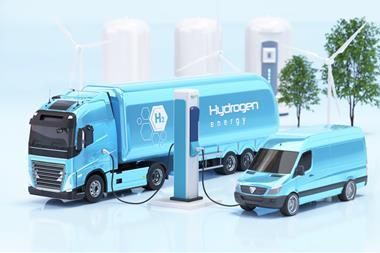While the world hasn’t yet arrived at the vision created by the ’Back to the Future’ film trilogy, which suggested today’s vehicles might be powered by processed waste, we are beginning to see the advent of what has always been regarded as a fuel of the future hydrogen.
Hydrogen is the most abundant element in the universe, and when used in a fuel cell, is known to be highly efficient, and better still, leaves no nasty carbon residue. It combines with oxygen from the air in the fuel cell to produce electricity and water. Hydrogen fuel cell vehicles have the same electric drive as a battery-electric car replacing the internal combustion engine but use hydrogen as the fuel to create the electricity, rather than a battery.
I know this because I recently met Emma Guthrie, business development manager at Air Products plc, a global industrial gas company which is involved with funded demonstration projects that have seen the installation of a small network of hydrogen fuelling stations in London; including a bus fuelling station in Stratford, East London; and two public unmanned hydrogen fuelling stations one near Heathrow Airport (where she kindly showed me round) and one on a Sainsbury’s forecourt in Hendon, north London.
"Hydrogen is much more likely to be the fuel of the future than LPG," she says. "The emissions that come from LPG are equivalent to diesel. These types of fuels will be on their way out because of air quality reasons.
"There’s a global trend towards looking at electric-drive road transport, moving away from the traditional internal combustion engine vehicle, and we are certainly seeing strong movements towards fuel cell technology. If you look at the development plans of the major global automotive manufacturers, almost all of them see hydrogen fuel cells as part of their future, particularly Hyundai and Toyota, who have both launched series production models of fuel cell passenger cars the Hyundai ix35FCEV and the Toyota Mirai and both of those vehicles are on the road in the UK today. The UK is seen by the manufacturers as an attractive place for hydrogen vehicle deployment."
The advantages of hydrogen as a power source in road vehicles are that fuelling takes place in a matter of minutes compared to charging a battery-electric vehicle, which is measured in hours. And while you can, in principle, charge a car overnight from home, it’s not necessarily practical in all cases such as if you live in a flat.
Also the range of a hydrogen-powered vehicle at up to 400 miles is considerable compared with a battery-electric vehicle, which typically covers less than 100 miles.
"There are also practical issues around the mass conversion of passenger cars to battery-electric, not least the provision of a mass charging infrastructure," stresses Guthrie. "If you looked at installing charging points right across the country it could be difficult to achieve, and would put pressure on the national grid."
For petrol retailers, the development of hydrogen technology on road vehicles all seems less concerning for the future format of their businesses, than if battery-electric vehicles really took hold as the major mode of transport in the future. The process of fuelling with hydrogen is markedly similar for a motorist to filling up with petrol or diesel: you drive up to a pump on a forecourt and the hydrogen is delivered through a nozzle, which is inserted into the car in the ’normal’ way.
Air Products was involved with the installation of the first truly publicly accessible hydrogen station in the UK developed by a European consortium with 14 partners from industry and academia, known as HyTEC (Hydrogen Transport in European Cities). It is on a publicly accessible piece of land near to Hatton Cross tube station, close to Heathrow Airport. It’s a standalone station that’s accessible to authorised users 24 hours-a -day. "The HyTEC project delivered a fleet of fuel cell taxis as well as two of the first Hyundai ix35 FCEV cars," says Guthrie. "These were the first commercially leased fuel cell vehicles that came into the UK and are being used by Transport for London."
"The second project we’ve been involved with is the London Hydrogen Network Expansion (LHNE). This was carried out as a collaborative demonstration project with some funding support from UK government.
"We investigated many locations before we settled on a site at a Sainsbury’s facility in Hendon, north London the UK’s first supermarket forecourt-hosted hydrogen fuelling station. Significantly, it’s the first time a hydrogen fuelling station has been placed in a retailing environment a setting that is familiar and comfortable to the general public."
The hydrogen station is in close proximity to the petrol station itself. It has gas storage, a compressor and hydrogen is delivered as pressurised gas. The site was opened last March and is used daily by the cars and vans in the LHNE project. It’s also used by the Hyundais and Toyotas being deployed within the London area.
"The Hendon hydrogen station provides a useful case study," says Guthrie. "What became apparent when we applied for planning permission was that the hydrogen fuelling site had to be formally distinct from the petrol station, and not integrated in any way. It’s technically possible to put a hydrogen filling station with a dispenser that’s integrated into the petrol fueling environment it’s been done in other parts of the world. But the challenge for both us as an industrial supplier and the UK regulatory bodies, is that no rules have been written so far as to how to cope with hydrogen in this petrol retailing setting."
However Air Products, as well as the other main industrial gas companies, are all members of the British Compressed Gas Association (BCGA), which has drafted a code of practice for hydrogen fuelling stations. BCGA is working with the Association for Petroleum and Explosives Administration (APEA) to see if that content can be transferred and then incorporated into the Blue Book the established technical guidance on providing information about storage and dispensing of petroleum products for motor vehicles produced jointly by the APEA and the service station panel of the Energy Institute (EI).
"There are clearly a few challenges to overcome to ensure that what is unfamiliar in the fuel retailing world today, becomes increasingly familiar," says Guthrie." But there’s a lot to be excited about concerning hydrogen fuelling. We now see real commitment coming from the automotive manufacturers; we see series production of electric drive vehicles; and there are a lot of opportunities to see how hydrogen can sit beside traditional fuels."

































No comments yet